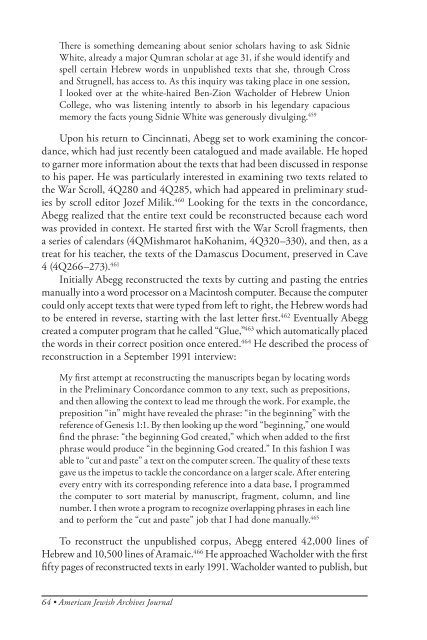The American Jewish Archives Journal, Volume LXI 2009, Number 1
The American Jewish Archives Journal, Volume LXI 2009, Number 1
The American Jewish Archives Journal, Volume LXI 2009, Number 1
You also want an ePaper? Increase the reach of your titles
YUMPU automatically turns print PDFs into web optimized ePapers that Google loves.
<strong>The</strong>re is something demeaning about senior scholars having to ask Sidnie<br />
White, already a major Qumran scholar at age 31, if she would identify and<br />
spell certain Hebrew words in unpublished texts that she, through Cross<br />
and Strugnell, has access to. As this inquiry was taking place in one session,<br />
I looked over at the white-haired Ben-Zion Wacholder of Hebrew Union<br />
College, who was listening intently to absorb in his legendary capacious<br />
memory the facts young Sidnie White was generously divulging. 459<br />
Upon his return to Cincinnati, Abegg set to work examining the concordance,<br />
which had just recently been catalogued and made available. He hoped<br />
to garner more information about the texts that had been discussed in response<br />
to his paper. He was particularly interested in examining two texts related to<br />
the War Scroll, 4Q280 and 4Q285, which had appeared in preliminary studies<br />
by scroll editor Jozef Milik. 460 Looking for the texts in the concordance,<br />
Abegg realized that the entire text could be reconstructed because each word<br />
was provided in context. He started first with the War Scroll fragments, then<br />
a series of calendars (4QMishmarot haKohanim, 4Q320–330), and then, as a<br />
treat for his teacher, the texts of the Damascus Document, preserved in Cave<br />
4 (4Q266–273). 461<br />
Initially Abegg reconstructed the texts by cutting and pasting the entries<br />
manually into a word processor on a Macintosh computer. Because the computer<br />
could only accept texts that were typed from left to right, the Hebrew words had<br />
to be entered in reverse, starting with the last letter first. 462 Eventually Abegg<br />
created a computer program that he called “Glue,” 463 which automatically placed<br />
the words in their correct position once entered. 464 He described the process of<br />
reconstruction in a September 1991 interview:<br />
My first attempt at reconstructing the manuscripts began by locating words<br />
in the Preliminary Concordance common to any text, such as prepositions,<br />
and then allowing the context to lead me through the work. For example, the<br />
preposition “in” might have revealed the phrase: “in the beginning” with the<br />
reference of Genesis 1:1. By then looking up the word “beginning,” one would<br />
find the phrase: “the beginning God created,” which when added to the first<br />
phrase would produce “in the beginning God created.” In this fashion I was<br />
able to “cut and paste” a text on the computer screen. <strong>The</strong> quality of these texts<br />
gave us the impetus to tackle the concordance on a larger scale. After entering<br />
every entry with its corresponding reference into a data base, I programmed<br />
the computer to sort material by manuscript, fragment, column, and line<br />
number. I then wrote a program to recognize overlapping phrases in each line<br />
and to perform the “cut and paste” job that I had done manually. 465<br />
To reconstruct the unpublished corpus, Abegg entered 42,000 lines of<br />
Hebrew and 10,500 lines of Aramaic. 466 He approached Wacholder with the first<br />
fifty pages of reconstructed texts in early 1991. Wacholder wanted to publish, but<br />
64 • <strong>American</strong> <strong>Jewish</strong> <strong>Archives</strong> <strong>Journal</strong>

















